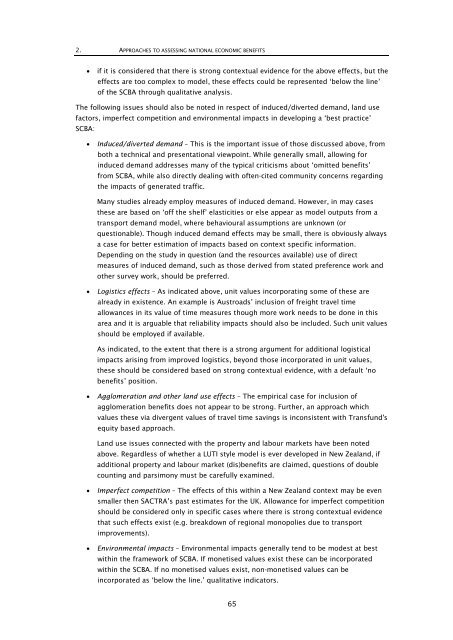Research 350 - NZ Transport Agency
Research 350 - NZ Transport Agency
Research 350 - NZ Transport Agency
Create successful ePaper yourself
Turn your PDF publications into a flip-book with our unique Google optimized e-Paper software.
2. APPROACHES TO ASSESSING NATIONAL ECONOMIC BENEFITS<br />
• if it is considered that there is strong contextual evidence for the above effects, but the<br />
effects are too complex to model, these effects could be represented ‘below the line’<br />
of the SCBA through qualitative analysis.<br />
The following issues should also be noted in respect of induced/diverted demand, land use<br />
factors, imperfect competition and environmental impacts in developing a ‘best practice’<br />
SCBA:<br />
• Induced/diverted demand – This is the important issue of those discussed above, from<br />
both a technical and presentational viewpoint. While generally small, allowing for<br />
induced demand addresses many of the typical criticisms about ‘omitted benefits’<br />
from SCBA, while also directly dealing with often-cited community concerns regarding<br />
the impacts of generated traffic.<br />
Many studies already employ measures of induced demand. However, in may cases<br />
these are based on ‘off the shelf’ elasticities or else appear as model outputs from a<br />
transport demand model, where behavioural assumptions are unknown (or<br />
questionable). Though induced demand effects may be small, there is obviously always<br />
a case for better estimation of impacts based on context specific information.<br />
Depending on the study in question (and the resources available) use of direct<br />
measures of induced demand, such as those derived from stated preference work and<br />
other survey work, should be preferred.<br />
• Logistics effects – As indicated above, unit values incorporating some of these are<br />
already in existence. An example is Austroads’ inclusion of freight travel time<br />
allowances in its value of time measures though more work needs to be done in this<br />
area and it is arguable that reliability impacts should also be included. Such unit values<br />
should be employed if available.<br />
As indicated, to the extent that there is a strong argument for additional logistical<br />
impacts arising from improved logistics, beyond those incorporated in unit values,<br />
these should be considered based on strong contextual evidence, with a default ‘no<br />
benefits’ position.<br />
• Agglomeration and other land use effects – The empirical case for inclusion of<br />
agglomeration benefits does not appear to be strong. Further, an approach which<br />
values these via divergent values of travel time savings is inconsistent with Transfund's<br />
equity based approach.<br />
Land use issues connected with the property and labour markets have been noted<br />
above. Regardless of whether a LUTI style model is ever developed in New Zealand, if<br />
additional property and labour market (dis)benefits are claimed, questions of double<br />
counting and parsimony must be carefully examined.<br />
• Imperfect competition – The effects of this within a New Zealand context may be even<br />
smaller then SACTRA’s past estimates for the UK. Allowance for imperfect competition<br />
should be considered only in specific cases where there is strong contextual evidence<br />
that such effects exist (e.g. breakdown of regional monopolies due to transport<br />
improvements).<br />
• Environmental impacts – Environmental impacts generally tend to be modest at best<br />
within the framework of SCBA. If monetised values exist these can be incorporated<br />
within the SCBA. If no monetised values exist, non-monetised values can be<br />
incorporated as ‘below the line.’ qualitative indicators.<br />
65
















